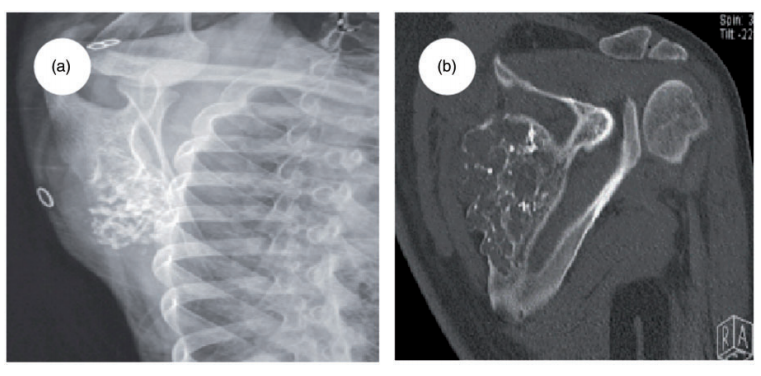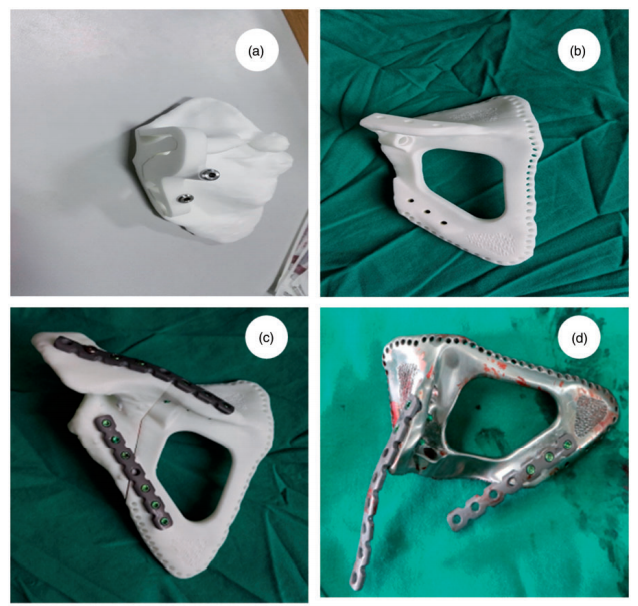In the recently published ‘Application of a three-dimensional printed segmental scapula prosthesis in the treatment of scapula tumors,’ authors Linglong Deng, Xing Zhao, Chi Wei, Wengiang Qu, Li Yu, and Shaobo Zhu explore better ways to salvage limbs, focusing on the potential found in 3D printing.
While there are a host of benefits that make 3D printing enticing to the medical community overall—from the affordability factor to speed in production—what is most groundbreaking is the ability to offer patient-specific treatment. For this study, the authors focused on the effects of chondrosarcoma has on the scapula (a part of the body most commonly known as the shoulder blade).

Imaging examination findings of the left shoulder. (a) An X-ray showed an irregular shadow with a bone lesion on the scapula, situated in the S1 region. (b) A computed tomography scan revealed a moderate low-density bony lesion.
Due to aggressive tumors caused by chondrosarcoma, along with the resulting irregular patterns, limb salvage is usually recommended. Offering implants is known to be a challenge, and while limb salvage is often the best course of action, that does not mean it is simple. Today, chondrosarcomas are responsible for 20 percent of malignant bone tumors, stealing functionality from the shoulder for many patients, as well as shortening their lives in all too many cases.
“After resection of the tumor, we were eager to obtain a prosthesis with the same size and shape as the original removed portion without the tumor,” stated the researchers. “Hence, we viewed a mirror model of the scapula from the healthy side as an affected side implant. Consequently, having used mirror imaging technology, we synthesized the 3D image file of the S1 region of the left scapula without tumor and named it N-S1 (that is the prosthesis) according to the right scapula. Finally, the STL files were uploaded to a Tornier 3D printer (SAS, Montbonnot, France) to acquire a solid 3D model consisting of nylon resin material.”
Ultimately, the prosthesis was created from titanium and screwed into the scapula. After four weeks, the patient was able to move his hand, elbow, and shoulder, and is still in good condition with no pain in the shoulder. The researchers point out that 3D printing allows for ‘accurate reconstruction,’ but there is much to be considered before performing a successful procedure like this as the prosthesis must always be customized for the patient due the irregularity of tumors, leaving it properly shaped and stable for connection to what is left of the scapula after the mass is removed.

Major intraoperative surgical procedures. (a) The osteotomy navigation template was attached to the scapula landmark to assist with tumor resection. (b) The excised tumor tissue. (c) The remaining rotator cuff was reconstructed with the prosthesis.
With 3D printing, the researchers were able to simulate the procedure, training ahead of time, as well as contouring the reconstructive plate. The operation was successful, streamlined due to the previous simulation, and with a ‘perfect match’ shown between the prosthesis and scapula. They did note some constrictions, however:
- The entire process—from 3D design to completion of surgery—was time-consuming.
- The technology and materials were expensive.
- Follow-up time was ‘relatively short.’
Overall though, with 3D printing they were successful in reconstruction, customization, and even more with the allowed simplification of operations which are generally otherwise complicated.
“The 3D printing technology can fulfill the requirements of a highly individualized design, thereby displaying unique advantages in the manufacturing of the implant,” concluded the researchers.
The impacts that 3D printing is having on the medical realm are enormous, and 3D printed models as well as implants have changed the lives of patients all over the world, educating surgeons and medical students about tumors and necessary surgeries, and offering new methods of treatment. What do you think of this news? Let us know your thoughts! Join the discussion of this and other 3D printing topics at 3DPrintBoard.com.

Solid three-dimensional model of the left scapula and preoperative simulation. (a) A navigation template stuck to the removed portion of the scapula (S1). (b,d) The nylon and titanium alloy prostheses (N-S1) were printed using mirror imaging technique. Many holes were designed at the edge of the prosthesis for soft tissue reconstruction. (c) The retained portion of the scapula (S2) and the prosthesis (N-S1) matched well via the reconstruction plate shaped in advance.
Subscribe to Our Email Newsletter
Stay up-to-date on all the latest news from the 3D printing industry and receive information and offers from third party vendors.
Print Services
Upload your 3D Models and get them printed quickly and efficiently.
You May Also Like
Formlabs Fuse 1+ 30W: Small SLS Printer, Massive Impact
Disclosure: With Formlabs permission I was able to sell my 4L and use that to help with the purchase of the Fuse 1+ and Fuse Sift. Aside from allowing me...
ASTM International Works with UK MoD on America Makes Project
The UK Ministry of Defense (MoD) will work with ASTM International on a $1.1 million project to let it work in closer concert with the US Department of War (DoW)....
3D Printing News Briefs, January 15, 2026: Project Call, Sports Medicine, Aluminum Alloy, & More
In today’s 3D Printing News Briefs, America Makes announced the winners of a $1.1 million Project Call, Austal USA named a new Vice President for Business Development and External Affairs,...
UK Government Partnership to Develop 3D Printed Metal Alloys for Nuclear Fusion
The UK Atomic Energy Authority (UKAEA), a government-funded research organization, has demonstrated a persistent interest in developing metal additive manufacturing (AM) materials for nuclear fusion applications, including multiple phases of...




























